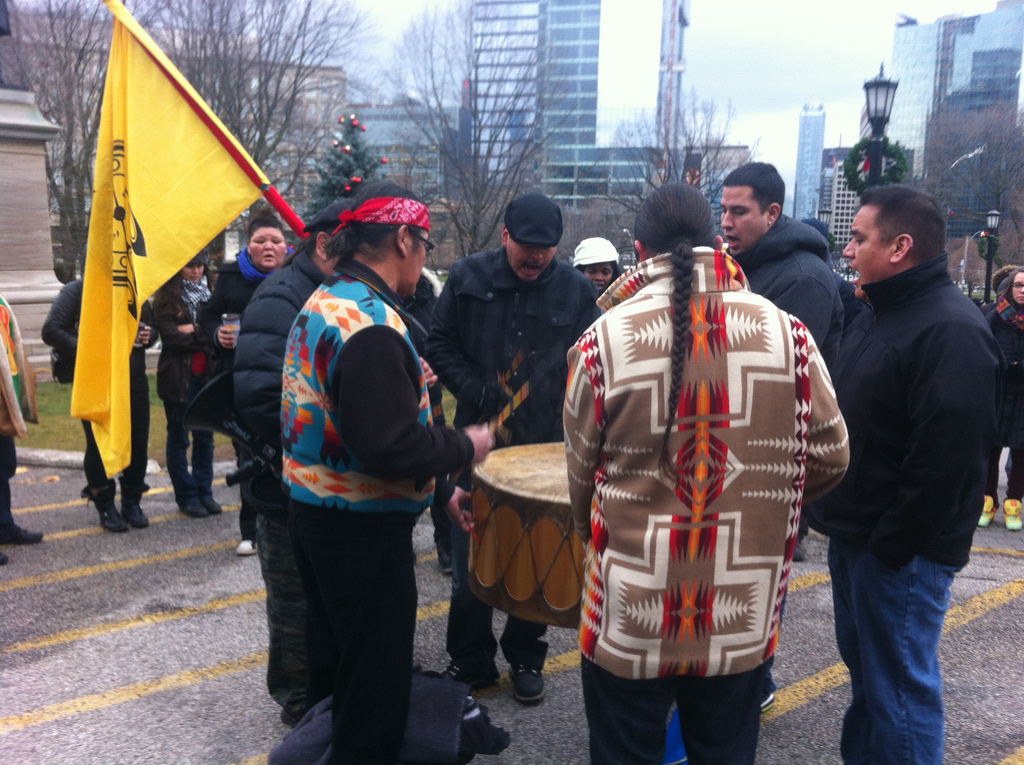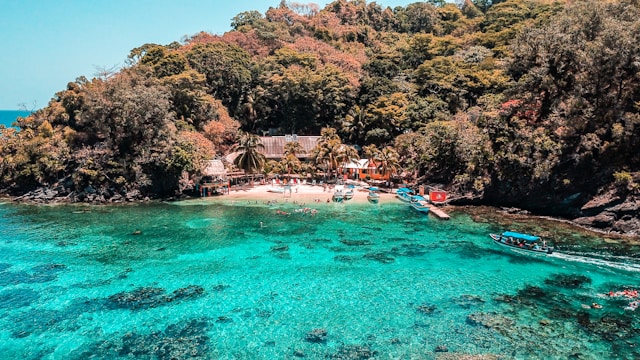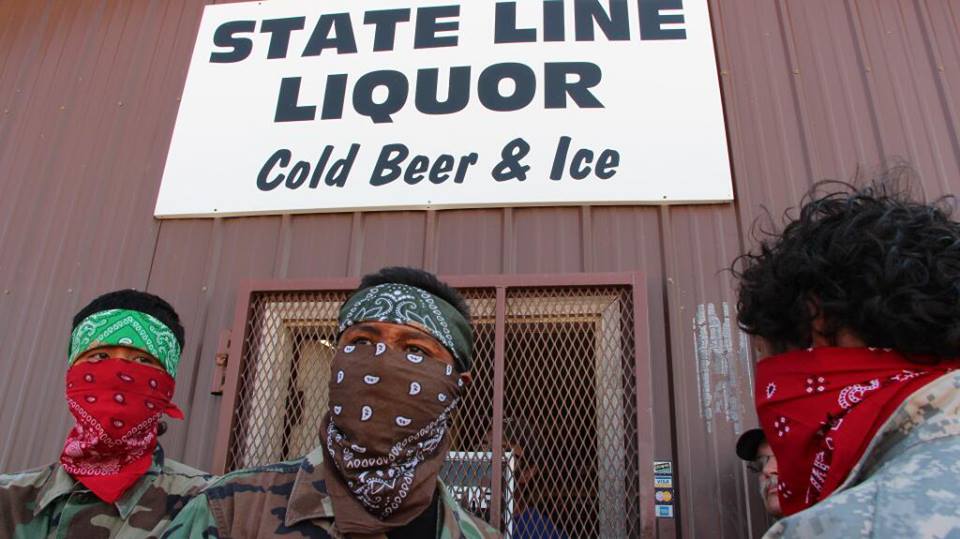
by Deep Green Resistance News Service | Jun 21, 2013 | ACTION, Colonialism & Conquest, Indigenous Autonomy
By Inter Press Service
“We can’t sow our fields, which they have rented for next to nothing. What good do we get out of it?” Guadalupe Ramírez complained about wind farms operating in the southern Mexican state of Oaxaca.
Ramírez said, “the governments play favourites with big business; our land produces more than what the companies are offering … They said they would come to help us, but that’s a lie,” this 62-year-old Zapotec Indian told IPS when she and other campesinos came to Mexico City from the municipality of Unión Hidalgo, 560 kilometres to the south, to protest the situation.
The Piedra Larga I wind farm, which has been operating in the town since October 2012, comprises 145 wind turbines producing 90 MW of power. It is the property of Desarrollos Eólicos Mexicanos (DEMEX), a subsidiary of the Spanish company Renovalia Energy and the private U.S. investment firm First Reserve.
In 2007 DEMEX approached local people and began to sign rental contracts with members of the “ejido” or communal land, treating them as if they were independent smallholders and not communal rights holders, and setting an average monthly rental of 20 dollars a hectare. The campesinos of Unión Hidalgo farm between three and four hectares each.
But in other municipalities wind energy companies are paying up to 80 dollars a hectare. Moreover, land tenure in Unión Hidalgo is collective, and all decisions pertaining to ejido land have to be made by the entire assembly of the ejido members, so the contracts signed are not actually valid – a fact that at first was not noticed by those who rented out their land.
Ejido members farming communal land in the municipality accuse DEMEX of tricking them by not explaining the clauses of contracts that were written in Spanish rather than Zapotec, of not calling the obligatory assembly of the ejido members, of polluting their land and of denying them freedom of movement on their land.
In 2014 the company will begin operating the Piedra Larga II wind farm, occupying 300 hectares in Unión Hidalgo, which has a population of 13,970, mainly native Zapotec people. A Resistance Committee against the Wind Farm Project has been created, several of whose members came to the capital to protest on Wednesday Jun. 12.
Their protest shows the increasing discontent of Mexican communities with wind energy projects because of their economic, environmental and social consequences. The future of the sector is turning cloudy, just when Global Wind Day was celebrated on Saturday Jun. 15.
The energy ministry estimated on Wednesday Jun. 12 that wind energy generates 1,304 MW in Mexico, followed by geothermal power with 812 MW, biomass and biogas with 581 MW and mini-hydropower projects with 450 MW. Without including large hydroelectric power stations, renewable energy sources contribute five percent of the total national energy supply, and the proportion is increasing.
The strong winds in the isthmus of Tehuantepec, the narrowest part of Mexico which includes parts of the southern states of Oaxaca, Tabasco, Veracruz and Chiapas, have made it an epicentre for several wind farm projects. Land ownership in this area is primarily collective and communities are governed by traditional custom.
To date wind energy exploitation occupies 11,000 hectares nationwide, with investments since 2007 totalling five billion dollars, according to the Mexican Wind Energy Association (AMDEE).
The energy reform of 2008 allows individuals and businesses to generate their own electricity from renewable sources, supply it to the national grid and be rewarded with preferential feed-in tariffs.
As a result, many companies are buying cheap wind energy to become self-sufficient in energy and reduce their electricity bills. However, critics of this strategy argue that the communities where wind parks are installed have the least to gain.
“There is a pattern of human rights violations in the communities. Wind energy companies advertise themselves well, offering money and jobs, but the jobs are temporary. The companies’ actions are not transparent, nor do they meet established standards,” Alejandra Ancheita, the head of Proyecto de Derechos Económicos, Sociales y Culturales (ProDESC – Economic, Social and Cultural Rights Project), told IPS.
Following the wind energy boom in Oaxaca, activists fear the negative aspects of the model will be repeated in wind farm projects in other states.
“They have brought no benefits. The energy companies violate collective property rights, agrarian laws and the traditional laws of indigenous peoples,” Bettina Cruz, the founder of the Assembly of Indigenous Peoples of the Isthmus of Tehuantepec in Defence of Land and Territory (APIIDTT), told IPS.
DEMEX has denied the allegations against it, saying that the contracts are valid and that it has the necessary authorisations for construction and operation of the wind park.
“Conditions in the communities have not improved,” said Benjamin Cokelet, head of the Project on Organising, Development, Education and Research (PODER), an NGO for corporate accountability. In his view, the companies may be in violation of international conventions.
In the towns of San Dionisio del Mar, Álvaro Obregón and San Vicente, close to Unión Hidalgo, local people have blocked similar wind energy projects through direct protests and legal appeals.
In the towns of San Dionisio del Mar, Álvaro Obregón and San Vicente, close to Unión Hidalgo, local people have blocked similar wind energy projects through direct protests and legal appeals.
For instance, in San Dionisio, the Spanish company Mareña Renovables is planning a 392 MW wind park with 75 million dollars of financing from the Inter-American Development Bank. But the project is at a standstill due to legal action.
On Tuesday Jun. 11 the Unión Hidalgo Resistance Committee presented a lawsuit to the agrarian court, which deals with land rights, seeking to invalidate the contracts that have been signed and suspend the working of the wind farm and its expansion, with immediate effect.
In April, they presented a complaint to PROFEPA, Mexico’s federal agency for environmental protection, against pollution caused by the wind park.
“It’s not right for the government to negotiate with the companies over our land. We have been badly off ever since they arrived. They say it’s clean energy, but that’s not true: lubricating oil from the turbines is contaminating the soil and the groundwater, the blades are killing birds, and the turbines are noisy,” Esteban López, a 55-year-old Zapotec Indian who grows maize and sorghum, told IPS.
The three private banks financing the project are signatories to the Equator Principles, a set of voluntary guidelines for assessing social and environmental risk in credits, adhered to by more than 70 international financial institutions since 2003.
Cokelet said PODER is considering lodging a grievance under the Equator Principles over irregularities in Unión Hidalgo.
“We are not smallholders, we are community farmers with collective tenure, and the company ignored that. They didn’t explain what they were going to do on our land. The contracts are unfair and one-sided,” Ramírez said.
By 2020, Mexico expects to generate some 12,000 MW from wind power.
From Inter Press Service
Photo by Luca Bravo on Unsplash
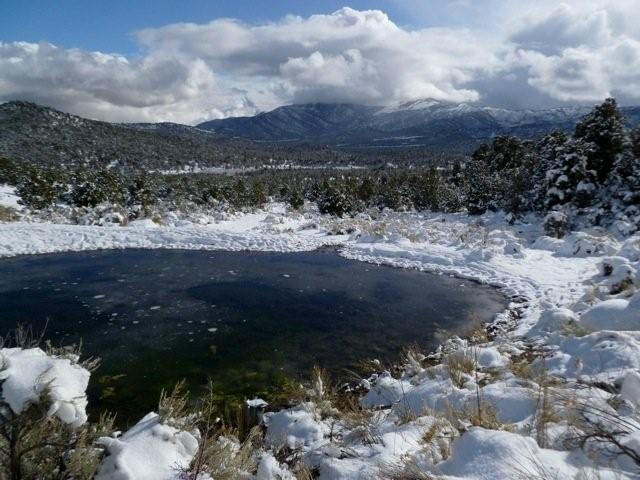
by Deep Green Resistance News Service | Jun 17, 2013 | Biodiversity & Habitat Destruction, Colonialism & Conquest, Indigenous Autonomy, Strategy & Analysis
nBy Michael Carter, Deep Green Resistance Colorado Plateau
The Pipeline Proposal
The Great Basin stretches from Utah’s Great Salt Lake to the Sierra Nevada Mountains and from southern Idaho to southern California. About seven inches of rain falls in Nevada a year, and some areas receive less than five. The Great Basin is a cold desert, and in eastern Nevada and western Utah, it has been getting drier for a decade. [1]
The Southern Nevada Water Authority (SNWA), the water agency for Las Vegas, Henderson, and North Las Vegas, proposes pumping up to 200,000 acre-feet annually from eastern to southern Nevada through 300 miles of pipeline. An acre-foot is enough water to cover an acre of land a foot deep, or about 325,850 US gallons. Cost estimates vary from $3.5 billion (what SNWA tells the public) to $15 billion dollars (what SNWA was required by law to tell the State Engineer). This project is seen as a threat by several Indian tribes and rural communities, and is expected to do immense damage to many rare endemic species, desert vegetation, and the land itself, much of which is open range. [2]
Basin and Range
Life in the Great Basin’s valleys, human and otherwise, depends on shallow groundwater, springs, and creeks, which in turn depend on groundwater flows from rain and snow in mountain ranges. 200,000 acre-feet is about 65 billion gallons of water, equivalent to the average flow of Nevada’s Humboldt River. SNWA claims that it can pump this water from the Spring, Delamar, Dry Lake, and Cave Valleys without harm; though it’s clear to those who live in the Great Basin that if most of the water flowing in from the mountains is drawn away, eventually most everything in the valleys will die.
The Bureau of Land Management’s final decision on the right-of-way for the project [3] allows for the pumping of 150,000 annual acre-feet. [4] A drawdown projection commissioned by the Goshute Tribe [5] (and other analyses) reflect a far more destructive outcome than the SNWA claims. Access to Snake Valley (much of which is in Utah) groundwater is still in dispute, but the US Geological Survey has concluded the multiple valleys’ aquifers are connected, so it’s likely that Utah’s groundwater would be impacted anyway. [6]
According to the Great Basin Water Network, “Independent hydrologists dispute it is possible to pump and export so much water without causing major environmental degradation and destroying the livelihoods of rural residents in eastern Nevada and western Utah. The area targeted for the massive pumping proposal is home to National Wildlife Refuges… Great Basin National Park is surrounded by the proposed groundwater pump and export project. The proposed pumping scheme would bring two hundred or more wells with power lines, roads, and linked buried pipelines to cover the valleys on both sides of the National Park—some right on the border of the park.
Communities like Baker, Nevada on the Utah border would have large production wells in their backyard sending local water to a city 300 miles away.” [7] As pipeline foe Rick Spilsbury puts it, “This would mean the end of any economic development anywhere near the drained areas. The likely result would be a mass emigration and the eventual transformation of the area into a national toxic dump site.” Impacts to land, water, and air could extend as far as Salt Lake City and its surrounding urban areas (which already have some of the worst air pollution in the US). Physicians for Social Responsibility predicts a dewatered basin-and-range country could increase downwind particulate pollution from dust storms, including the toxic mineral erionite. [8] In textbook fashion, the city of Las Vegas is exporting suffering and violence to import resources that it cannot acquire in its immediate landbase.
Overdrawn River
Author Marc Reisner wrote, “To some conservationists the Colorado River is the preeminent symbol of everything mankind has done wrong—a harbinger of a squalid and deserved fate. To its preeminent impounder, the US Bureau of Reclamation, it is the perfection of an ideal.” [9] In 2013, American Rivers announced the Colorado as the US’s most endangered river, and that “over-allocation and drought have placed significant stress on water supplies, river health, and fish and wildlife. To underscore the immediacy of the problem, the basin is facing another drought this summer. The Bureau of Reclamation’s report released in December stresses that there is not enough water to meet current demands across the basin, let alone support future demand increases.” [10]
Under the interstate Colorado River Compact of 1922, the entire state of Nevada was allowed 300,000 acre feet per year (AFY) of Colorado River water. One AFY is approximately 3380 liters per day, “the planned water usage of a suburban family household, annually. In some areas of the desert Southwest, where water conservation is followed and often enforced, a typical family uses only about 0.25 [AFY].” [11] The Imperial Irrigation District, whose water rights predate the 1922 Compact, owns approximately three million acre feet (MAF) per year, and the entire city of Los Angeles uses about one MAF per year. Though laws controlling the use of water are typically state, not federal, and vary widely from state to state (in Arizona, for instance, there is little legally recognized relationship between ground and surface water), the 1922 Compact is a binding agreement between states. The Upper Basin must deliver a total of 7.5 MAF per year to the Lower Basin (the dividing line is at Lee’s Ferry in Glen Canyon, in Utah), and the US must deliver one MAF a year to Mexico. [12] Across the entire Colorado River basin, nearly all climate models predict an increase in both aridity and flooding. [13]
As increasing temperatures force the jet stream further north and more water evaporate from soil and reservoirs like Lake Powell (where an average 860,000 acre-feet of water—about 8 percent of the Colorado River’s annual flow—is lost every year) [14], overall water availability will decrease even if summer storms and spring runoff paradoxically become more intense. 2012 was the first recorded year the Colorado River flow peaked in April. [15] Though the water level in Lake Mead (where Las Vegas siphons its water from) has priority over Lake Powell’s (upstream), Las Vegas has little water from the river’s apportionment overall because in 1922, when the Compact was made, there were very few people in Nevada and no guess at what Las Vegas might become.
Southern Nevada at one point had the highest growth rate in the US, but following the economic recession Nevada had the highest national rate of foreclosures, bankruptcies, and unemployment. In 2010, there were 167,564 empty houses in Nevada—one in seven. In Las Vegas, residential property prices have fallen by 50 percent on average from 2008 to 2011, when Nevada homes changed hands for an average of $115,000. [16] As one SNWA pipeline opponent remarked, “My house in Las Vegas dropped from $307,500 to be foreclosed, and then resold at $190,000.”
When the SNWA groundwater pipeline was first conceived, the water agency was planning for growth on a much higher trajectory, and this momentum has carried through the recession to the present day. So while southern Nevada’s water future in general is threatened by drought and Nevada’s small original apportionment, the groundwater pipeline is driven by hopes for future growth, not immediate need. [16]
Indigenous Human Rights
The Confederated Tribes of the Goshute, or CTGR (the name “Goshute” derives from the native word Ku’tsip or Gu’tsip, people of ashes, desert, or dry earth), [17] “reside in an isolated oasis in the foothills of the majestic Deep Creek Mountains on what is now the Utah/ Nevada state line,” according to their web page Protect Goshute Water. There are 539 enrolled tribal members, and about 200 of them live in Deep Creek Valley. “Our reservation lies in one of the most sparsely populated regions of the United States, and it has always been our home. Resulting from this isolation, we have benefited by retaining strong cultural ties to Goshute land, our traditions, and a resolute determination to protect our ways.
Ironically, water, the most elemental resource in our basin, is the very thing developers now seek to extract and send 300 miles away for Las Vegas suburbs. The Southern Nevada Water Authority’s pipeline proposal would draw 150,000 acre feet per year from the Great Salt Lake Watershed Basin lowering the water table, drying up our springs, and fundamentally changing access to water over this vast region for plants, wildlife, and people.” They go on to say that “SNWA’s groundwater development application is the biggest threat to the Goshute way of life since European settlers first arrived on Goshute lands more than 150 years ago.” [18]
In Spring Valley in eastern Nevada, a narrow band of swamp cedar trees mark the site of 1863 and 1897 US military massacres of Goshute and Shoshone peoples, and here is where the Goshute and Duckwater and Ely Shoshone tribes grieve and hold spiritual ceremonies. Goshute tribal chairman Ed Naranjo says that “Swamp Cedars is important to many tribes, certainly to CTGR, Ely, and Duckwater, but also to many Paiute, Shoshone, and Ute Tribes.” The Swamp Cedars Massacre is relatively obscure, compared to well-known massacres at Bear River [19] and Wounded Knee.
Goshute elders believe that murder victims physically and spiritually fed the swamp-cedar trees; according to former Goshute council chairman Rupert Steele, “Otherwise you’d never see swamp cedar grow this tall and strong.” In a 2011 Nevada State Engineer hearing, an SNWA attorney likened the Goshute beliefs to children fearing the bogeyman. The Spring Valley swamp cedar grove is one of many sites that could be drained by the SNWA pipeline. [20] A “Cultural Property and Cultural Landscape” report on Spring Valley, Nevada, prepared by an independent ethnographer for Goshute and Ely and Duckwater Shoshone tribes was ignored by the BLM in their environmental analysis. [21]
Rick Spilsbury, a Shoshone Indian, says that “As far as the Native Americans of Nevada and Utah are concerned, this is just a continuation of the land and resource grab that has existed since the authoring of the Bill of Rights. Those who take have been writing the rules. The Colorado River Compact was organized specifically to exclude Native Americans and Mexicans from having any water rights. And the omission of Federal water protections for Native Americans from State water affairs was obviously not an oversight, or it would have been fixed by now. Native Americans don’t have the legal ability to stop their exploitation. [22]
“The Western Shoshone still hunt and gather here—right where the worst of the environmental damage will be. The mass killing of life in this area will not only be the final blow to Western Shoshone culture, it will be a serious threat to their long-term sustainability—and even viability. Water is life. And SNWA intends to take it.”
Opposition
Not surprisingly, a water appropriation on this scale has been hard fought by those whose livelihoods will be affected, as well as indigenous communities and environmental groups. Even within southern Nevada there’s some rate-payer opposition [23]—the project’s costs will be added to water bills—and Utah’s governor Gary Herbert recently rejected a proposed agreement with the SNWA for Snake Valley groundwater. [24] Litigation on various aspects of this project may well proceed to the US Supreme Court.
(Though Herbert’s decision was widely praised by both West Desert ranchers and environmentalists, not everyone in Utah concurred. Ron Thompson, of the Washington County, Utah, Water Conservancy District, criticized the move as “hypocritical for us to tell Nevada not to develop a water project. Ultimately they will figure out how to do it.” [25] Washington County wants to build its own expensive water pipeline from Lake Powell to the St. George area, and Thompson thinks Governor Herbert is sacrificing a “positive tradition of bi-state cooperation” in turning the SNWA down. A Lake Powell pipeline opponent observed that “It’s imperative that opposition to both projects stays active and coordinated.” [26])
Deep Green Resistance’s Southwest Coalition proposes this strategy:
Though we’re too recently involved to have any legal standing, our emphasis on indigenous solidarity has drawn us to ally ourselves with the affected indigenous groups. Though their governments haven’t agreed to any formal affiliation, we offer them support through:
1. Organizing opposition in communities outside the reservations.
2. Fundraising for efforts to fight the pipeline, whatever that might be. Donations are tax-deductible and can be made by PayPal to deepgreenfertileground@gmail.com. Please put “SNWA” in the comments section. The Great Basin Water Network also accepts donations, at or Great Basin Water Network, P O Box 75, Baker, NV 89311 (Nevada non-profit #35-2278153).
3. Influencing public opinion and promoting taxpayer opposition to the pipeline.
4. Sponsoring educational events and outreach. This might include inviting indigenous people (and supporting travel costs) to events we can organize in Salt Lake City and Las Vegas to speak against the pipeline.
5. Organizing protests and rallies. We can help redefine this issue as one of human rights violation, not only environmental destruction.
6. Encouraging negative press coverage of the SNWA and pipeline proposal. Encouraging positive press coverage of the Great Basin’s unique beauty, and the long indigenous people’s relationship with it.
7. Discouraging project investors/lenders.
8. We can also organize and train for nonviolent civil disobedience to fight the pipeline construction, should legal or administrative efforts fail. This is a tactical tool that’s aimed at physically stopping construction. It’s not symbolic, it’s strategic; there are ways of minimizing the expense and suffering to activists and maximizing expense and delay of the enemy, and we feel it’s best to plan for the unfortunate possibility that this struggle may well arrive at this point. We believe it’s our responsibility as privileged members of the dominant culture to put our bodies between the bulldozers and indigenous peoples and lands.
Miscellaneous Articles
- “Goshutes blast BLM study on Las Vegas water pipeline,” Las Vegas Review-Journal, August 5, 2012, http://www.lvrj.com/news/goshutes-blast-blm-study-on-las-vegas-water-pipeline-165082706.html
- Joe Schoenmann, “Water Authority gets state agency’s backing for pipeline to transport water from Lincoln, White Pine counties,” Las Vegas Sun, September 12, 2012, http://www.lasvegassun.com/news/2012/sep/12/water-authority-gets-state-agencys-backing-pipelin/
- Cy Ryan, “Environmental impact statement issued for proposed water pipeline,” Las Vegas Sun, August 3, 2012, http://www.lasvegassun.com/news/2012/aug/03/environmental-impact-statement-issued-proposed-wat/
- David McGrath Schwartz, “Nevada leaders largely silent on pipeline controversy,” Las Vegas Sun, October 14, 2011, http://www.lasvegassun.com/news/2011/oct/14/nevada-leaders-largely-silent-pipeline-controversy/
- Tara Lohan, “Las Vegas Accused of Engineering Massive Water Grab: Is This the Future of the West?” AlterNet, January 25, 2013, http://www.alternet.org/environment/las-vegas-accused-engineering-massive-water-grab-future-west-photo-slideshow?image-1=11&paging=off
Endnotes
[1] “Great Basin Water Issues,” Great Basin Water Network, accessed December 26, 2012, http://www.greatbasinwater.net/issues/index.php This page offers a good overview of Great Basin water issues, including the SNWA proposed pipeline.
See the U.S. Drought Monitor for current data: The U.S. Drought Monitor. National Drought Mitigation Center at the University of Nebraska-Lincoln, United States Department of Agriculture, National Oceanic and Atmospheric Administration. http://droughtmonitor.unl.edu/
[3] Sandra Chereb, “BLM approves Las Vegas water pipeline project,” Las Vegas Review-Journal, December 27, 2012, http://www.lvrj.com/news/blm–approves–las–vegas–water–pipeline–project-184948361.html
“Clark, Lincoln, and White Pine Counties Groundwater Development Project Final EIS,” US DEPARTMENT OF THE INTERIOR BUREAU OF LAND MANAGEMENT, August 3, 2012, http://www.blm.gov/nv/st/en/prog/planning/groundwater_projects/snwa_groundwater_project/final_eis.html
“Clark, Lincoln, and White Pine Counties Groundwater Development Project EIS Record of Decision,” U.S. DEPARTMENT OF THE INTERIOR BUREAU OF LAND MANAGEMENT, December 27, 2012, http://www.blm.gov/nv/st/en/prog/planning/groundwater_projects/snwa_groundwater_project/record_of_decision.html
[4] “SNWA appears as if it’s planning on Snake Valley water, said Rob Mrowka of the Tucson-based Center for Biological Diversity.
Despite the fact that the Nevada engineer approved water rights of 84,000 acre feet, he said, the BLM is set to approve a pipeline capable of carrying 117,000 acre feet.” Christopher Smart, “BLM poised to OK Las Vegas plan to pump and pipe desert groundwater,” Salt Lake Tribune, August 6, 2012, http://www.sltrib.com/sltrib/politics/54624691-90/blm–eis–final–las.html.csp
Brian Maffly, “BLM’s decision on Nevada-Utah pipeline called ‘pure folly’; Right of way helps southern Nevada, but Utah’s Snake Valley water not in play—yet,” Salt Lake Tribune, December 28, 2012, http://www.sltrib.com/sltrib/news/55538357-78/nevada–blm–decision–groundwater.html.csp
[5] “Ancestral Lands/Drawdown Scenario Map,” Protect Goshute Water, accessed May 10, 2013
[6] “While the BLM’s final EIS spares Snake Valley along the Utah-Nevada border from groundwater pumping, critics say drilling in nearby valleys will draw down the aquifer beneath Snake Valley,” “Goshutes blast BLM study on Las Vegas water pipeline,” Las Vegas Review-Journal, August 5, 2012, http://www.lvrj.com/news/goshutes–blast–blm–study–on–las–vegas–water–pipeline-165082706.html
[7] “Great Basin Water Issues,” Great Basin Water Network, accessed May 11, 2013, http://www.greatbasinwater.net/issues/index.php
[8]“Dr. Jeff Patterson, president of PSR [Physicians for Social Responsibility], said Westerners should be worried because there is no evidence of any serious attempt to determine if erionite exists in the same areas that would be ‘de-watered by the proposed Las Vegas pipeline and would be kicked up in the particulate pollution. Erionite can cause serious lung disease and a highly lethal cancer called mesothelioma,’” Brian Moench, “No end to Nevada’s quest for water,” Salt Lake Tribune, April 6, 2013, http://www.sltrib.com/sltrib/opinion/56107724-82/utah–nevada–erionite–las.html.csp
[9] Reisner, Marc. Cadillac Desert. New York: Viking Penguin, 1986, 121.
[10] Amy Souers Kober, “Announcing America’s Most Endangered Rivers of 2013,” American Rivers, April 17, 2013, https://web.archive.org/web/20130531040706/http://www.americanrivers.org/newsroom/blog/akober-20130417-announcing-americas-most-endangered-rivers-2013.html
[11] Acre-foot,” Wikipedia, accessed May 14, 2013, http://en.wikipedia.org/wiki/Acre–foot
[12] The Colorado River is managed and operated under numerous compacts, federal laws, court decisions and decrees, contracts, and regulatory guidelines collectively known as ‘The Law of the River,’” “Colorado River Compact,” Wikipedia, accessed May 14, 2013, http://en.wikipedia.org/wiki/Colorado_River_Compact
[13] Melanie Lenart, “Precipitation Changes,” Southwest Climate Change Network, September 18, 2008, http://www.southwestclimatechange.org/node/790#references
Gregory J. McCabe, David M. Wolock, “Warming may create substantial water supply shortages in the Colorado River basin,” Geophysical Research Letters, Volume 34, Issue 22, November 27, 2007, http://onlinelibrary.wiley.com/doi/10.1029/2007GL031764/abstract;jsessionid=400E4E84287315178759E2F3CEDCB107.d02t03
[14] “Glen Canyon Dam,” Wikipedia, accessed December 10, 2012, http://en.wikipedia.org/wiki/Glen_Canyon_Dam
[15] COLORADO BASIN RIVER FORECAST CENTER , NATIONAL WEATHER SERVICE / NATIONAL OCEANIC AND ATMOSPHERIC ADMINISTRATION, accessed May 11, 2013, http://www.cbrfc.noaa.gov/rmap/peak/peakpoint.php?id=CCUC2
[16] Nick Allen, “Las Vegas: how the recession has hit Sin City,” The Telegraph, May 16, 2011, http://www.telegraph.co.uk/news/worldnews/northamerica/usa/8517423/Las-Vegas-how-the-recession-has-hit-Sin-City.html
[17] The Confederated Tribe of the Goshute. Pia Toya: A Goshute Indian Legend. Salt Lake City: University of Utah Press, 2000.
[18] “The Confederated Tribes of the Goshute Reservation,” Protect Goshute Water, accessed May 15, 2013
[19] Kristen Moulton, “At Bear River Massacre site, the names of the dead ring out,” Salt Lake Tribune, January 30, 2013, http://www.sltrib.com/sltrib/news/55727028-78/bear–massacre–river–shoshone.html.csp
[20] Stephen Dark, “Last Stand: Goshutes battle to save their sacred water,” Salt Lake City Weekly, May 9, 2012, http://www.cityweekly.net/utah/article-35-15894-last–stand.html?current_page=all
[21] Sylvester L. Lahren, Jr. Ph.D., “A Shoshone/Goshute Traditional Cultural Property and Cultural Landscape, Spring Valley, Nevada. Confidential and Proprietary Report for the Goshute Tribal Council,” Confederated Tribes of the Goshute Reservation, August 9, 2010.
[22] Christopher Smart, “Snake Valley water could land in U.S. Supreme Court,” The Salt Lake Tribune, August 7, 2012, http://www.sltrib.com/sltrib/politics/54642624-90/snake–valley–nevada–rights.html.csp
“Nevada Groundwater Conservation: The Problem,” Center for Biological Diversity, accessed December 26, 2012, http://www.biologicaldiversity.org/programs/public_lands/deserts/nevada/groundwater.html
Rob Mrowka, “Groups join together to confront water rights issue,” Desert Report, Center for Biological Diversity/Great Basin Water Network, June, 2011, accessed December 26, 2012, http://www.biologicaldiversity.org/programs/public_lands/deserts/nevada/pdfs/DR_Summer2011_Mrowka.pdf
George Knapp and Matt Adams, “I-Team: Court Ruling Emboldens Water Grab Opponents,” October 31, 2011,
[23] “Water pipeline hits opposition even in thirsty Vegas,” Salt Lake Tribune, August 16, 2011, http://www.sltrib.com/sltrib/news/52398491-78/vegas–las–nevada–utah.html.csp
[24] Christopher Smart, Judy Fahys and Brian Maffly, “Herbert rejects Snake Valley water pact with Nevada,” Salt Lake Tribune, April 3, 2013, http://www.sltrib.com/sltrib/news/56090274-78/valley–agreement–snake–utah.html.csp
[25] Brian Maffly, “Rejecting Nevada water deal hurts Utah, critics say,” Salt Lake Tribune, May 25, 2013,
[26] “Lake Powell Pipeline,” Citizens for Dixie’s Future, accessed May 27, 2013, http://citizensfordixie.org/lake–powell–pipeline/
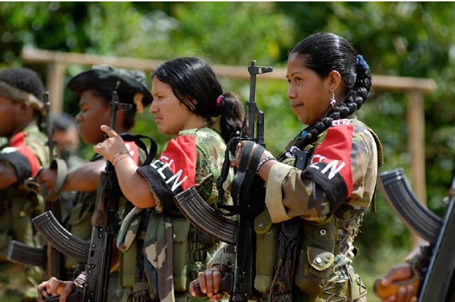
by Deep Green Resistance News Service | Jun 10, 2013 | Defensive Violence, Indigenous Autonomy, Mining & Drilling
By Jorge Barrera / APTN
A Colombia guerilla group is trying to draw Ottawa into its battle with a Toronto-based mining company which is quietly trying to secure the release of one of its executives who has been held hostage since January.
The Ejercito de Liberacion Nacional (ELN) kidnapped Gernot Wober, 47, on Jan. 18, during an attack on the Snow Mine camp in Bolivar state, which sits in the northern part of the country. The guerilla group kidnapped five other people, including three Colombians and two Peruvians, who have all since been released.
The guerilla group says that Wober, the vice-president of Toronto-based Braeval Mining Corp, won’t be released until the company gives up gold mining concessions in the San Lucas mountain range which the ELN claims were initially given to local miners who live in the area.
In a statement issued Wednesday and posted on the guerilla group’s website, the ELN took aim at the Canadian government.
“The Canadian government should at least be concerned about whether its anti-corruption laws are being followed by Canadian companies in their foreign operations,” said the ELN. “Neither the Colombian nor Canadian governments have bothered to investigate our accusations about the dispossession of four mining concessions held by communities in the southern part of Boliver (state) by the Northern American company Braeval Mining Corporation.”
The ELN claimed the Colombian government was increasing military operations against the group to secure Wober’s release.
The ELN is the smaller of Colombia’s main guerilla groups. It’s estimated the ELN has between 2,000 to 3,000 guerilla fighters.
A spokesperson for Braeval said the company has been advised not to comment on the kidnapping.
Foreign Affairs emailed a statement to APTN National News saying federal government “officials continue to work closely with our partners on the ground.” The statement said officials are also in contact with Wober’s family.
“The government of Canada will not comment on efforts to secure the hostage’s release,” said the statement. “Due to privacy considerations, we cannot provide additional information about the situation.”
The ELN has released no evidence to back its claims that Braeval wrongly obtained the mining concessions.
According to his on-line work history, Wober has extensive experience in the mining sector, including involvement in projects in the Yukon, the Northwest Territories, British Columbia and Manitoba.
The activities of foreign mining companies, including those based in Canada, have long been a point of contention among Indigenous and local communities in Colombia.
Under Canada’s free trade agreement with Colombia, Ottawa is required to present an annual report on human rights in Colombia every year. Last year’s report failed to report on human rights in the country.
The National Indigenous Organization of Colombia (NIOC) has called on Canada to pressure the Colombian government to respect Indigenous rights in its mining laws.
In a recent interview with Maria Patricia Tobon Yagari, a lawyer with the NIOC said that mining companies present a bigger threat than the armed groups because the firms fuel the violence.
“The presence of these miners have reinforced (the violence) because they have benefited from it. By using private security they have forced these Indigenous groups and Colombian campesinos to resist and it has increased the violence in the territories,” said Tobon Yagari.
Tobon Yagari was scheduled to appear on Parliament Hill on May 22 but her visa was initially denied by Ottawa.
Tobon Yagari said foreign mining firms have put pressure on the Colombian government to pass mining laws tailored in the interest of development.
“Of course Canadian miners have a large interest in getting legislation in their favour,” she said. “That is what is happening without our mining code and our situation in Colombia.”
Many Indigenous communities in Colombia are clinging precariously on the edge of extinction.
Of the 102 documented Indigenous nations in Colombia, 32 have populations under 500, 18 have populations of 200, while 10 have less than 100.
Tens of thousands of Indigenous people have been displaced from their territories which are often rich in minerals and hydrocarbons eyed by foreign mining firms.
Amnesty International has said it’s concerned about deepening ties between Canada and Colombia’s military as a result of the free trade deal.
“And recent changes to export controls in Canada to allow for the sale of automatic firearms to Colombia,” have added to list of problematic issues, said the international human rights organization.
The situation of Indigenous peoples in Colombia is so dire that the UN Special Rapporteur on Indigenous Peoples James Anaya has called for the UN special advisor on genocide to visit Colombia.
From APTN
